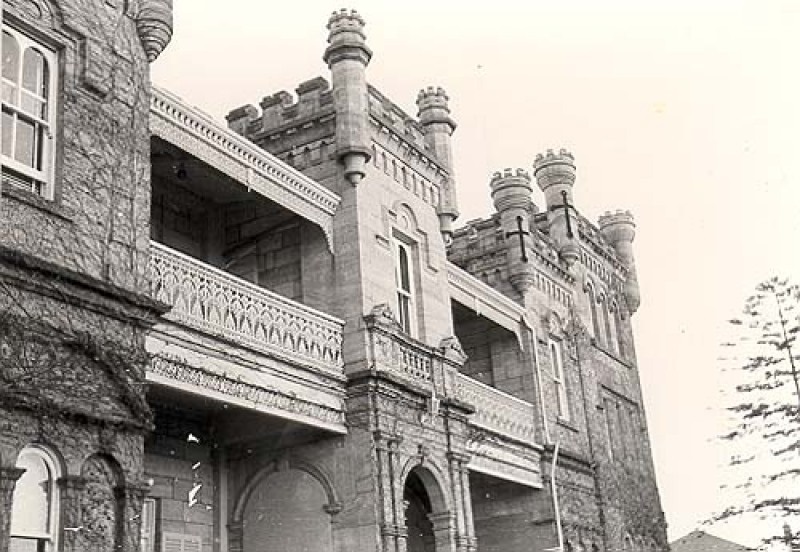Local history fast facts - F
A B C D E F G H I J K L M N O P Q R S T U V W X Y Z
FAIRLIGHT, Edgecliff Road, Edgecliff. Victorian Regency house built in 1855 by Mr Joseph William Cocks.
FAIRWATER, New South Head Road, Double Bay. Built by stockbroker Francis Joseph 1881-82 (J. HORBURY HUNT) acquired by Sir Oswald Fairfax in 1904 and been in the family ever since. Substantially and sympathetically altered in 1910 (MANSON).
For more information please see the Woollahra Libraries Digital Archive.
FAIRWEATHER STREET, Woollahra - named after Alexander T. Fairweather, an Alderman on Woollahra Council and Mayor in 1910. (see James Jervis / History of Woollahra, p. 124).
FENTON, Albert Street, Edgecliff. House designed by architect Robin Dods as his residence, built between 1918 and 1919.
FERNBANK, Edgecliff Road, Edgecliff. House built in 1884 by Freeman, a well known Sydney photographer and acquired by Sydney Gilchrist. In 1887, Miss Louisa Jane Gumey established a school there, moving to Kambala in Bellevue Hill, from which the present Rose Bay girl's school took its name. The house was one of a couple of identical Rustic Gothic houses the eastern one remaining mostly unchanged while Fernbank was vastly altered.
FERNLEIGH CASTLE, Fernleigh Avenue, Rose Bay. Small stone cottage built on the site in 1874 by C.W. Roberts, enlarged by Frank Bennett (Evening News) in 1892 into a Victorian Romanesque mansion with 'Norman' battlements and castellated towers.
For more information please see the Woollahra Libraries Digital Archive.

Front balconies of 'Fernleigh Castle', 1958. Woollahra Libraries Digital Archive, Ian Scott, pf002296.
FERRIES - The first ferry service in the area was to Watsons Bay, the excursion steamer, Victoria, for the Melbourne Steam Packet Company. The first regular service was in 1876 by W.L. Harmer with competition from Sir John Robertson from 1881 later, the Watsons Bay and South Shore Ferry Company Limited taken over by Sydney Ferries in 1920. Ferry services ran from time to time to Darling Point, Double Bay, Rose Bay (the Pier), Nielsen Park (excursion), Parsley Bay, Central Wharf, Vaucluse and Watsons Bay some calling at the Zoo wharf and Clifton Gardens on the other side of the harbour. These ferry services, except for excursion and yacht racing custom ceased in 1933. Nicholson's conducted a regular run to Rose Bay for a while starting in the early 1970s with government ferry services to Watsons Bay getting under way around 1987.
For more information please see the Woollahra Libraries Digital Archive.
FIONA - Part of Ascham School was named after one of the islands in the Hebrides. It was part of Thomas Smith's 'grant' and bought by Edward Knox who built the Classical Revival House in 1864 to the designs of J.F. HILLY, the porte cochere by G.A Morrell. Knox founded CSR and was Chairman up to 1901, the year he died. The Knox family lived there until 1946.
FLETCHER'S IRON WORKS, Edgecliff Road, Woollahra. Fletcher's Iron Works operated a plant making the 'Younger' stove and iron railings etc. from 1870 to around 1950. The plant was demolished in 1952 and the site is now occupied by Holy Cross College Primary School. The street nearby carrying the firm's name was previously known as Australia Street and renamed in their honour.
FLETCHER STREET, Woollahra. Name changed from Australia Street to Fletcher Street in 1947.
FLINTON - early Paddington house, built 1830s by Roger Therry and demolished in 1926, purchased by the Benevolent Society in 1901 to become part of the Royal Hospital for Women, Paddington. see Royal Hospital for Women for more information.
FLYING BOAT BASE - Rose Bay. Established on the northern half of Lyne Park, Rose Bay, first flight by COOEE - VH-ABF on 5 July, 1938. The last commercial flight was on 10 September, 1974. Subsequently, the base was dismantled and the area reverted to public park.
For more information please see the Woollahra Libraries Digital Archive.
FORSYTH PARK, Rose Bay - According to Vaucluse Council Minutes of 11.06.1913, lots 47 and 48 of the Tivoli Estate were proclaimed a public park - Forsyth Park in honour of Alderman Adam Forsyth, the Mayor of Vaucluse in 1913.
For more information please see the Woollahra Libraries Digital Archive.
FORTIFICATIONS - Gun emplacements were constructed at South Head (1852 then 1871-6), Steele Point (Nielsen Park, 1871), Signal Hill (1893 then 1939) and Christison Park (late WWII), and the ordinance put in place at various times.
For more information please see the Woollahra Libraries Digital Archive.
FOSTER AVENUE, Double Bay - named in 1937 after William F. Foster, Mayor of Woollahra from 1923 - 1925.
FOSTER PARK, Double Bay - named in 1937 after William F. Foster, Mayor of Woollahra from 1923 - 1925.
FUNCTIONALIST STYLE OF ARCHITECTURE - popular in the 1920's and 1930's. Arose out of the 'Modeme' school of European architecture (Le Corbusier, Bauhaus etc. also referred to as 'Expressionlet') characterfeed by severely clean lines, rounded corners, steel framed windows, light toned cement render, roof parapets. Prime examples in Woollahra include The Robert's House in Vaucluse and The Kings Theatre in Rose Bay North.